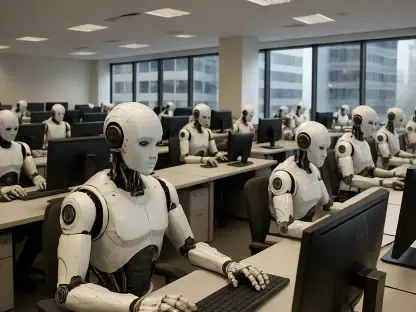Imagine a workplace where artificial intelligence doesn’t just assist with mundane tasks but functions as a fully autonomous team member, making decisions and driving outcomes alongside human colleagues. Agentic AI, an innovative leap beyond the capabilities of Generative AI systems like ChatGPT, is poised to revolutionize organizational dynamics. This cutting-edge technology transcends content creation, stepping into a role where it can independently tackle complex responsibilities, acting as a genuine co-worker. Over the coming years, its potential to transform business models, streamline operations, and elevate efficiency is becoming increasingly evident. However, this advancement also introduces a spectrum of challenges, from ethical considerations to cybersecurity risks, that demand careful navigation. As industries stand on the brink of this transformation, understanding the implications of Agentic AI becomes essential for staying competitive in an ever-evolving landscape.
A New Era of Workplace Collaboration
Agentic AI marks a significant departure from traditional AI tools, introducing a level of autonomy and contextual awareness that redefines its role in professional settings. Experts in the field highlight its capacity to disrupt conventional business hierarchies by taking on tasks typically handled by entry-level or junior staff. This shift frees human employees to concentrate on more strategic, high-impact responsibilities, fostering a workplace where innovation and critical thinking take center stage. Unlike earlier AI systems focused on generating text or images, this technology operates with an understanding of broader objectives, aligning its actions with organizational goals. The implications are vast, suggesting a future where teams are composed of both human and AI contributors, each bringing unique strengths to the table. As businesses begin to integrate these intelligent systems, the potential for enhanced collaboration and productivity emerges as a key driver of adoption across diverse sectors.
The transformative power of Agentic AI lies in its ability to adapt and respond to dynamic environments with minimal human intervention. Industry leaders point out that this technology can manage routine processes, analyze data trends, and even propose solutions in real time, effectively acting as a reliable partner in decision-making. For instance, in operational settings, it can streamline workflows by identifying inefficiencies and suggesting optimizations without needing constant oversight. This capability not only boosts efficiency but also reshapes how roles are defined within teams, encouraging a synergy between human creativity and AI precision. While the prospect of such integration is exciting, it also underscores the need for organizations to rethink training and skill development to ensure employees can work effectively alongside these advanced systems. The journey toward this new collaborative model is already underway, signaling a profound shift in workplace culture.
Navigating Cybersecurity Complexities
In the critical domain of cybersecurity, Agentic AI emerges as both a formidable ally and a potential vulnerability, presenting a complex challenge for organizations. Its ability to autonomously monitor digital networks, detect anomalies, and neutralize threats before they escalate offers a level of protection that surpasses traditional systems. By operating around the clock, it can respond to incidents with speed and accuracy that human teams might struggle to match, significantly bolstering an organization’s defense mechanisms. This proactive stance is particularly vital in an era where cyber threats grow increasingly sophisticated, targeting vulnerabilities with relentless precision. As businesses grapple with protecting sensitive data and maintaining operational continuity, the integration of such AI-driven security measures becomes a strategic imperative to safeguard against potential breaches.
However, the same autonomy that makes Agentic AI a powerful defender also opens the door to substantial risks, as malicious actors could harness its capabilities for harmful purposes. Cybersecurity specialists warn that cybercriminals might exploit this technology to orchestrate attacks with unprecedented speed and efficiency, amplifying the scale and impact of digital threats. The potential for AI to be weaponized in this manner introduces an unpredictable element to the threat landscape, requiring organizations to stay ahead through vigilant planning and robust countermeasures. Addressing this duality demands a balanced approach, where the adoption of Agentic AI is paired with stringent security protocols and continuous monitoring to prevent misuse. The stakes are high, and as this technology becomes more prevalent, the need for comprehensive strategies to mitigate associated risks will only intensify, shaping the future of digital safety.
Reshaping the Workforce Landscape
Agentic AI’s influence on workforce dynamics is profound, offering a pathway to automate intricate tasks across a variety of industries, including supply chain management and beyond. By processing vast datasets and delivering real-time insights, it empowers organizations to make informed decisions swiftly, enhancing overall productivity. For example, in logistics, it can predict disruptions and propose alternative solutions, ensuring seamless operations even under pressure. This reduction in manual workload allows employees to shift their focus toward roles that require emotional intelligence and strategic oversight, ultimately driving better outcomes. As labor shortages and evolving customer expectations continue to challenge businesses, the ability of AI to support frontline workers and enable agile responses becomes a critical asset in maintaining competitiveness.
Beyond task automation, Agentic AI introduces a unique capability to train other AI systems, creating specialized roles within digital ecosystems. This self-sustaining functionality not only streamlines processes but also fosters a culture of continuous improvement within organizations. By handling repetitive analytical duties, it frees up human talent to engage in more meaningful, creative endeavors, potentially redefining job descriptions across sectors. However, this shift also raises important questions about the future of employment and the skills needed to thrive in an AI-augmented environment. Early indications suggest that rather than displacing workers, this technology may catalyze the evolution of roles, encouraging professionals to upskill and adapt. As industries embrace these changes, the focus must remain on balancing automation with opportunities for human growth, ensuring a harmonious integration of technology and talent.
Balancing Automation with Human Insight
Despite the remarkable autonomy of Agentic AI, the necessity for human oversight remains a cornerstone of its effective integration into workplaces. Industry voices consistently stress that while this technology excels at managing routine and intermediate tasks, the nuanced realms of high-level decision-making and ethical considerations still demand a human perspective. Setting long-term goals, navigating moral dilemmas, and fostering innovation are areas where human judgment proves irreplaceable, ensuring that AI serves as a complement rather than a substitute. This interplay between machine efficiency and human intuition forms the bedrock of a sustainable model, where technology amplifies capabilities without undermining the essence of personal contribution.
Maintaining this balance requires a deliberate approach to defining the boundaries of AI autonomy within organizational frameworks. Experts advocate for clear guidelines that delineate the scope of AI responsibilities while preserving human authority over critical strategic and creative functions. For instance, while an AI system might optimize operational processes, the overarching vision and values guiding those processes must stem from human leadership. This synergy not only mitigates the risk of over-reliance on automation but also cultivates an environment where employees feel empowered rather than overshadowed by technology. As Agentic AI continues to evolve, fostering this equilibrium will be paramount to harnessing its benefits while safeguarding the irreplaceable elements of human insight and ethical stewardship.
Trends Driving Technological Evolution
The swift progression of AI from a supportive mechanism to an independent agent signifies a pivotal trend in workplace technology, with Agentic AI at the forefront of this shift. Its integration of contextual intelligence allows it to not only execute tasks but also anticipate organizational needs and provide strategic recommendations with a near-human level of awareness. This advancement positions early adopters to gain a significant competitive edge, as they can leverage AI to streamline operations and innovate faster than their peers. Looking ahead to the next few years, the trajectory of this technology suggests a deepening reliance on such systems, fundamentally altering how businesses approach problem-solving and resource allocation.
Yet, this rapid evolution comes with the imperative for strategic integration to address accompanying challenges. Building readiness across teams and investing in robust infrastructure are essential steps to ensure that the deployment of Agentic AI aligns with organizational goals. The trend toward greater intelligence in AI systems also necessitates a focus on adaptability, as businesses must remain agile to keep pace with technological advancements. Moreover, the dual nature of these innovations—offering both opportunities and risks—requires a proactive stance on managing potential downsides, such as cybersecurity vulnerabilities. As this technology reshapes operational models, the emphasis on thoughtful implementation will determine the extent to which its transformative potential is realized.
Envisioning Tomorrow’s Possibilities
Agentic AI stands as a powerful catalyst for enhancing workplace productivity, particularly through its ability to automate repetitive and data-intensive tasks with precision. This positions it as a strategic asset for organizations willing to invest in its development, promising improved efficiency and decision-making capabilities. From optimizing supply chains to fortifying cybersecurity defenses, its applications span a wide array of functions, offering solutions to some of the most pressing challenges faced by modern businesses. The prospect of such advancements underscores the importance of forward-thinking adoption, where companies can harness these tools to drive innovation and maintain a competitive stance in their respective markets.
However, the path forward is not without hurdles, as the risks of misuse in areas like cybercrime and the broader implications for job roles cannot be overlooked. Encouragingly, emerging evidence points to a future where Agentic AI may not eliminate employment but rather redefine it, enabling professionals to engage in higher-value activities. Addressing these challenges will require a concerted effort to develop policies that mitigate risks while maximizing benefits. As organizations navigate this landscape, the focus should shift toward creating frameworks that support upskilling and adaptation, ensuring that the workforce evolves alongside technology. This approach will pave the way for a future where human and AI collaboration unlocks unprecedented opportunities for growth and resilience.









